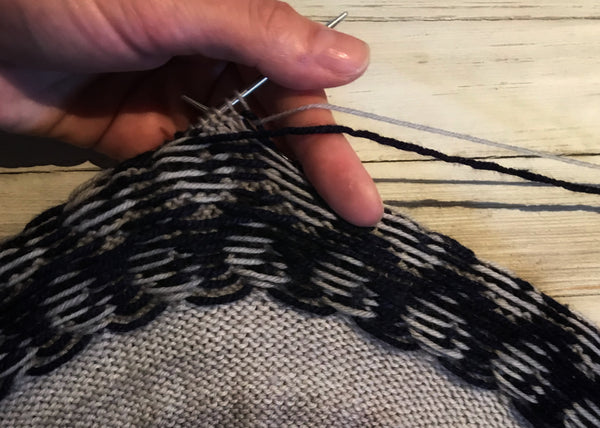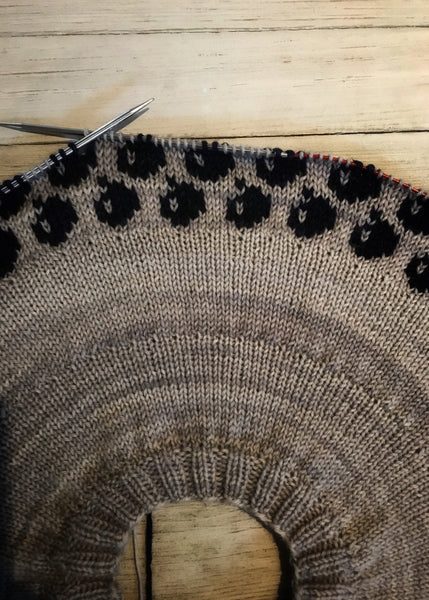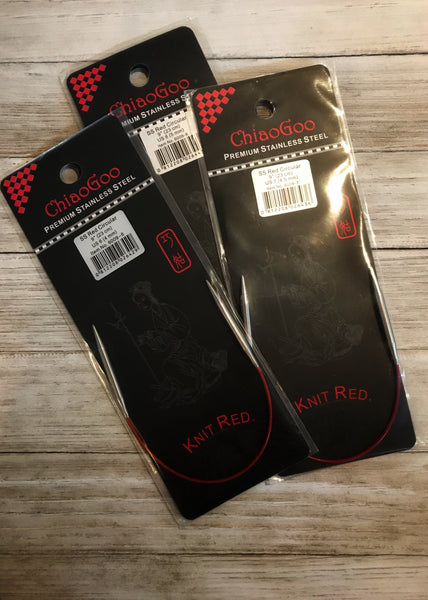For the longest time I was very intimidated by patterns that had color work. I will be honest in saying that they were the ones I drooled over the most but really lacked confidence with all that color! Since childhood I've had a deep love for Fairisle. I know that I had some, purchased not handmade, but felt really good in them. So when I knit my first one, I realized that it wasn't difficult just very engaging!
I started off with smaller motifs and never ever did I think that I would not only be super excited to knit them but to DESIGN them...WHHAAAA??! I'm completely obsessed with color work. The unlimited amount of designs and color combinations; for me it's the most fun I've ever had with my knitting.
Now, even after knitting a few patterns with Stranded Color work, I find myself with areas that I wanted to improve on. The learning never stops, nor would I want it too! But I have a few little tricks that I've learned along the way that have helped me and will hopefully get you to jump on the ever so popular color work band wagon, because I wouldn't want intimidation to stop you like it stopped me. That band wagon or should we call it a party bus is way too fun to let it pass you by!
Knitters either knit stranded color work at a looser tension or a tighter tension than the rest of their knitting. In researching the topic further, it seems that the majority of us are on the same party bus and knit at a tighter tension. I've mentioned a few basics in a previous blog and we'll briefly go over those first.
DOMINANT AND NON DOMINANT STRANDS
The contrasting color that you are using to create your pattern is generally the one that should be dominant. All this means is that when working with your strands; keep your contrasting color on the bottom. It has a longer strand when carried on the bottom which allows for more slack therefore less likely to recede into your work. You want your pattern to pop.

In the first picture, I'm ready to knit with Nuit. I'm keeping that strand crossing over on the bottom to allow for more strand length therefore less likely to recede into my work.

In the second photo I'm ready to knit with Gris-Gris. I will keep that stand crossing over the top of the contrasting color. Not only will this keep the back of your work tidy but it allows for consistency in holding the strands in your fingers and with the magic of memory power you will get a nice momentum going.
NEEDLE UP!! (OR DOWN???)
If you are on my bus, we knit at a much tighter tension. It really is trial and error as we all knit different. First I went up one needle size. Felt great, thinking I have this "in the bag"!! A couple of rounds in I'm excited to look and low and behold the main color is still puckering in between the contrasting color. OK, let's needle up 2 sizes. That was what worked best for me! It feels like the needle size is too big and the stitches are tight on the first round but you know what? It really helps!
SPREAD OUT YOUR STITCHES!!
When knitting circular yokes you get quite a few stitches on your needles. They start to bunch and you're knitting along not paying attention to what's going on besides Grey's Anatomy.....for the third time! When you go to look at the pretty design and spread out your work, stitches start to disappear into the background. When your work is all bunched up on the needles the strands in the back are crossing a shorter distance causing you to pull them too tight when stretching out your work. As I start to increase my stitches I will also up my cord size to a longer length so that none of the stitches have room to bunch. They are all stretched out. The strand on the back will go the full distance it needs to. This has probably been the easiest adjustment but perhaps the most important in my experience.
YARN UP!!
This is something new I tried with this latest design that you are getting a little sneak peek into. I'm using Bis-sock in Gris-Gris and DK Pure in Nuit for my contrasting color. The idea first popped in my head when the pattern on the front is raindrops and I was wondering how I could make them look raised. I didn't need to needle size up; I used the same size needle throughout the entire color work section and just made sure my stitches were always spread out. The best thing about my Interchangeable Chiaogoo needles is that I can continue to add my longer cords and the stitches never bunch. I'm knitting around what reminds me of a Frisbee!! But you know what? It's turning out fantastic!

There's also the topic of long floats. A float is the strand of yarn that is not being knit but rather being loosely carried behind the knit stitches. It seems as though a majority of knitters consider crossing yarn over more than 5 stitches is considered a long float. I guess it depends on the person. I like this "knitting without rules" vibe that's going around. While I follow some rules by the book, other times you really need to do what's best for your knitting project. If you have a long float all you need to do is catch it in the yarn you are currently knitting with and continue knitting.

In the above photo I am currently knitting with Gris-Gris. The Nuit strand is being carried over 7 stitches. To avoid the strand being too long, place it over top of the Gris-Gris and continue to knit the remaining stitches with Gris-Gris. You can catch the yarn after 3 or 4 stitches, there’s no real rule as such to when you should catch it. It's all about personal preference.
The reason you want to avoid long floats is to avoid getting your fingers or jewelry caught into them while putting on your sweater. In saying that if you want to carry your yarn across 7 stitches and are not concerned about a long float...then by all means; have long floats!! Your project, your rules!!
BLOCK YOUR WORK!!
Lastly but most definitely not of least importance; BLOCK YOUR WORK!!! In my books, blocking is magic. You may have areas of concern in your work whether it's color work or not but let me tell you! Blocking will more than likely resolve any little issues you have going on. You'd be surprised at how the uneven stitches or slight puckering in color work will just resolve itself with a blocking! It truly is magical! Check out this blog on how to safely wash your knitted projects!
Have you found any other little helpful tips that might help when knitting color work? If so, PLEASE share them!!
FAVORITE NEW FINDS!!
I have to share this AMAZING find with you. Not necessarily new to everyone but these are new to me. I can't say that I hate knitting with double points because I don't but I can say I don't really love it. I knit fast and switching needles slows me down LOL Magic Loop was never my thing, I would prefer double points over magic Loop. So, what if you could knit small circumference knitting without double points and Magic Loop? ENTER Chiaogoo 9 inch Circulars!!!! Oh my goodness! These have improved my sleeve knitting speed tremendously!! Thank you Chiaogoo you have NEVER let me down yet!!

Have you tried these out yet??

